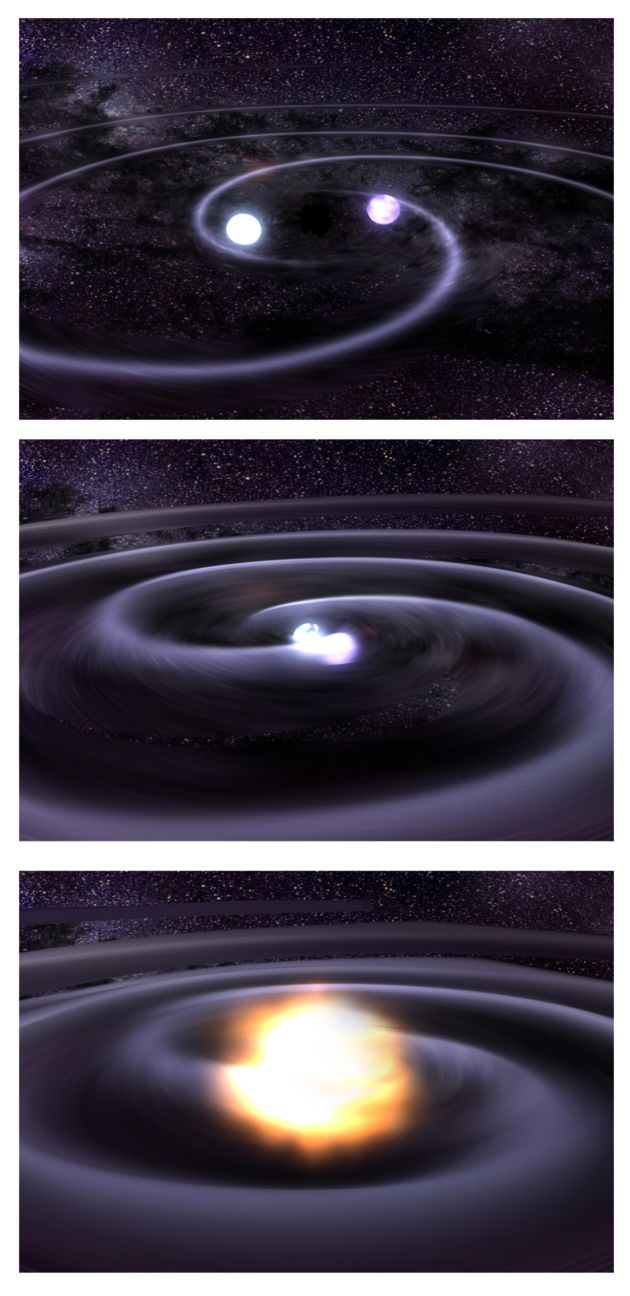Two Stars Poised to Merge

MINNEAPOLIS, MN - Two densestars whipping around each other at breakneck speed may be the strongest knownsource of Einstein's space-trembling gravity waves.
The double star - called RXJ0806 - was discovered in 1994 in X-rays. Later shown to be blinking on and offevery 5.4 minutes, the two-star setup is believed to be a pair of white dwarfs- the dense ashes of burnt-out stars - rotating around each other.
The implied separation isjust 50,000 miles - a mere one-fifth the distance between the Earth and theMoon, making this the closest stellar pair ever observed. The tangled duoshould be booming out gravity waves - undulations in the fabric ofspace and time predicted by Einstein's theory of general relativity.
"Those waves havestill not been detected directly, but there is indirect evidence," saidTod Strohmayer, who presented the results here last week at a meeting of theAmerican Astronomical Society meeting.
Strohmayer, of NASA'sGoddard Space Flight Center, presented data from the Chandra X-ray Observatorythat shows the time between the X-ray blips is decreasing by 1.2 millisecondsevery year. The implication is that the dwarfs are orbiting faster and faster,as they gradually fall into each other at a rate of one inch per hour.
This "spin-up" isconsistent with rotational energy being lost to gravity waves. The amount ofenergy radiated in gravity waves in all directions could be 100 times theenergy our Sun puts out in light, according to Strohmayer.
The study will be detailedin the Astrophysical Journal.
Get the Space.com Newsletter
Breaking space news, the latest updates on rocket launches, skywatching events and more!
Gravitational ticking
This is not the first timethat two objects have been seen spinning faster over time. The radio pulsesfrom the Hulse-Taylor pulsar were found to be getting closertogether due to gravity wave emission between the pulsar and an orbitingneutron star companion.
Also presented at thismeeting, Ingrid Stairs of the University of British Columbia and colleaguesfound that the distance between a double-pulsar system (PSR J0737-3039A and B)is shrinking at about two and a half inches per day, just as expected fromenergy loss to gravity waves.
"Things are tickingalong just as Einstein would have predicted," Stairs said.
Although gravity waves haveyet to be detected directly, future missions will be sure to look at thisnewly-identified white dwarf pair, which is 1,600 light years from Earth in theconstellation Cancer.
"When LISA [the LaserInterferometer Space Antenna] searches for gravitational wave sources, this onemight stick out like a sore thumb," Strohmayer said.
LISA, scheduled for 2012 launch, willinvolve three satellites orbiting 3 million miles (5 million kilometers) apartin a triangle formation. As gravity waves - traveling at the speed of light -wash up on the Earth's shores, the satellites can detect a change in theirseparation far less than the width of an atom.
"As a gravitationalwave source J0806 is very bright," said Lee Finn, the director of theCenter for Gravitational Wave Physics at Penn State University, in an emailmessage.
Finn expects that -relative to each other - the LISA satellites will bob one quadrillionth of ameter (roughly the size of an atomic nucleus) every 160 seconds in the J0806surf.
Opposing faces
The white dwarfs areassumed to each have about half the mass of the Sun, but their radii are likelycomparable to that of the Earth, which means their matter is densely packed.The compact size allows the dwarfs to orbit far closer than normal stars could.
Questions remain as to whatmechanism is causing the observed X-rays to go on and off. One possibility isthat a hot X-ray spot on one of the dwarfs comes in and out of our view as thedwarfs rotate around each other.
Evidence for thishypothesis comes from the fact that the pair blinks in visible light as well.The timing of the visible flashes are opposite that of the X-ray flashes: justas the X-rays turn on/off, the visible turns off/on.
This offset might bebecause the hot X-rays from the spot heat up the opposing face of the otherdwarf - causing it to emit visible light. It is as if the white dwarfs are twodancers twirling around each other - one with a smile beaming in X-rays, theother reflecting that gaze in the visible.
When will this dance end?
Strohmayer said the twodwarfs should continue losing energy to gravity waves and merge between 500,000and one million years from now. That event, theory says, would unleash acolossal burst of gravitational waves.
A movie depicting how themerger might play out is available here.
This article is part ofSPACE.com's weekly Mystery Monday series.
- Pair of Supermassive Black Holes Inhabit Same Galaxy, Destined to Collide
- Neutron Star Collisions Common, Study Suggests
- New Wave Telescope Begins Hunt for Gravity
Join our Space Forums to keep talking space on the latest missions, night sky and more! And if you have a news tip, correction or comment, let us know at: community@space.com.

Michael Schirber is a freelance writer based in Lyons, France who began writing for Space.com and Live Science in 2004 . He's covered a wide range of topics for Space.com and Live Science, from the origin of life to the physics of NASCAR driving. He also authored a long series of articles about environmental technology. Michael earned a Ph.D. in astrophysics from Ohio State University while studying quasars and the ultraviolet background. Over the years, Michael has also written for Science, Physics World, and New Scientist, most recently as a corresponding editor for Physics.









